 |
| History of California |
|---|
| To 1899 |
| Gold Rush (1848) |
| American Civil War (1861-1865) |
| 1900 to present |
| Maritime |
| Railroad |
| Slavery |
| Los Angeles |
| Sacramento |
| San Diego |
| San Francisco |
| San Jose |
The California Gold Rush (1848–1855) began on January 24, 1848, when gold was discovered by James Marshall at Sutter's Mill in Coloma, California.[1] News of the discovery soon spread, resulting in some 300,000 men, women, and children coming to California from the rest of the United States and abroad.[2]
These early gold-seekers, called "forty-niners," traveled to California by sailing ship and in covered wagons across the continent, often facing substantial hardships on the trip. While most of the newly-arrived were Americans, the Gold Rush attracted tens of thousands from Latin America, Europe, Australia and Asia. At first, the prospectors retrieved the gold from streams and riverbeds using simple techniques, such as panning, and later developed more sophisticated methods of gold recovery that were adopted around the world. Gold, worth billions of today's dollars was recovered, leading to great wealth for a few; many, however, returned home with little more than they started with.
The effects of the Gold Rush were substantial. San Francisco grew from a tiny hamlet of tents to a boomtown, and roads, churches, schools and other towns were built. A system of laws and a government were created, leading to the admission of California as a state in 1850. A unique social structure evolved. New methods of transportation developed as steamships came into regular service and railroads were built. Agriculture, California's first big attraction, developed on a wide scale throughout the state as gold mines produced less. However, the Gold Rush also had negative effects: Native Americans were attacked and pushed off traditional lands, race and ethnic tensions formed, and gold mining caused environmental harm.
Overview
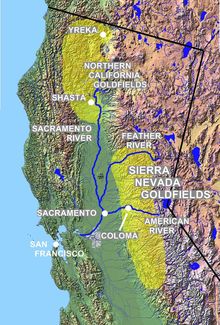
The Gold Rush started at Sutter's Mill, near Coloma.[3] On January 24, 1848 James W. Marshall, a foreman working for Sacramento pioneer John Sutter, found pieces of shiny metal in the tailrace of a lumber mill Marshall was building for Sutter, along the American River.[4] Marshall quietly brought what he found to Sutter, and the two of them privately tested the findings. The tests showed Marshall's particles to be gold. Sutter was dismayed by this, and wanted to keep the news quiet because he feared what would happen to his plans for an agricultural empire if there were a mass search for gold.[5] However, rumors soon started to spread and were confirmed in March 1848 by San Francisco newspaper publisher and merchant Samuel Brannan. The most famous quote of the California Gold Rush was by Brannan; after he had hurriedly set up a store to sell gold prospecting supplies,[6] Brannan strode through the streets of San Francisco, holding aloft a vial of gold, shouting "Gold! Gold! Gold from the American River!"[7] With the news of gold, many families trying their luck at Californian farming decided to go for the gold, becoming some of California's first miners.
On August 19 1848, the New York Herald was the first major newspaper on the East Coast to report that there was a gold rush in California; on December 5, President James Polk confirmed the discovery of gold in an address to Congress.[8] Soon, waves of immigrants from around the world, later called the "forty-niners," invaded the Gold Country of California or "Mother Lode." As Sutter had feared, he was ruined; his workers left in search of gold, and squatters invaded his land and stole his crops and cattle.[9]
San Francisco had been a tiny settlement before the rush began. When residents learned of the discovery, it at first became a ghost town of abandoned ships and businesses whose owners joined the Gold Rush,[10] but then boomed as merchants and new people arrived. The population of San Francisco exploded from perhaps 1,000[11] in 1848 to 25,000 full-time residents by 1850.[12] As with many boomtowns, the sudden influx of people strained the infrastructure of San Francisco and other towns near the goldfields. People lived in tents, wood shanties, or deck cabins removed from abandoned ships.[13]
In what has been referred to as the "first world-class gold rush,"[14] there was no easy way to get to California; forty-niners faced hardship and often death on the way. At first, most Argonauts, as they were also known, traveled by sea. From the East Coast, a sailing voyage around the tip of South America would take five to eight months,[15] and cover some 18,000 nautical miles (33,000 km). An alternative was to sail to the Atlantic side of the Isthmus of Panama, to take canoes and mules for a week through the jungle, and then on the Pacific side, to wait for a ship sailing for San Francisco.[16] There was also a route across Mexico starting at Veracruz. Eventually, most gold-seekers took the overland route across the continental United States, particularly along the California Trail.[17] Each of these routes had its own deadly hazards, from shipwreck to typhoid fever and cholera.[18]
To meet the demands of the arrivals, ships bearing goods from around the world—porcelain and silk from China, ale from Scotland- poured into San Francisco as well.[19] Upon reaching San Francisco, ship captains found that their crews deserted and went to the gold fields. The wharves and docks of San Francisco became a forest of masts, as hundreds of ships were abandoned. Enterprising San Franciscans turned the abandoned ships into warehouses, stores, taverns, hotels, and one into a jail.[20] Many of these ships were later destroyed and used for landfill to create more buildable land in the boomtown.
Within a few years, there was an important but lesser-known surge of prospectors into far Northern California, specifically into present-day Siskiyou, Shasta and Trinity Counties.[21] Discovery of gold nuggets at the site of present-day Yreka in 1851 brought thousands of gold-seekers up the Siskiyou Trail[22] and throughout California's northern counties.[23] Settlements of the Gold Rush era, such as Portuguese Flat on the Sacramento River, sprang into existence and then faded. The Gold Rush town of Weaverville on the Trinity River today retains the oldest continuously-used Taoist temple in California, a legacy of Chinese miners who came. While there are not many Gold Rush era ghost towns still in existence, the well-preserved remains of the once-bustling town of Shasta is a California State Historic Park in Northern California.[24]
Gold was also discovered in Southern California but on a much smaller scale. The first discovery of gold, at Rancho San Francisco in the mountains north of present-day Los Angeles, had been in 1842, six years before Marshall's discovery, while California was still part of Mexico.[25] However, these first deposits, and later discoveries in Southern California mountains, attracted little notice and were of limited consequence economically.[25]
By 1850, most of the easily accessible gold had been collected, and attention turned to extracting gold from more difficult locations. Faced with gold increasingly difficult to retrieve, Americans began to drive out foreigners to get at the most accessible gold that remained. The new California State Legislature passed a foreign miners tax of twenty dollars per month, and American prospectors began organized attacks on foreign miners, particularly Latin Americans and Chinese.[26] In addition, the huge numbers of newcomers were driving Native Americans out of their traditional hunting, fishing and food-gathering areas. To protect their homes and livelihood, some Native Americans responded by attacking the miners. This provoked counter-attacks on native villages. The Native Americans, out-gunned, were often slaughtered.[27] Those who escaped massacres were many times unable to survive without access to their food-gathering areas, and they starved to death. Novelist and poet Joaquin Miller vividly captured one such attack in his semi-autobiographical work, Life Amongst the Modocs.[28]
Forty-niners
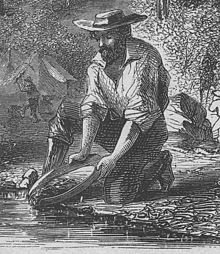
The first people to rush to the gold fields, beginning in the spring of 1848, were the residents of California themselves—primarily agriculturally oriented Americans and Europeans living in Northern California, along with Native Americans and some Californios (Spanish-speaking Californians).[29] These first miners tended to be families in which everyone helped in the effort. Women and children of all races were often found panning next to the men. Some enterprising families set up boarding houses to accommodate the influx of men; in such cases, the women often brought in steady income while their husbands searched for gold.[30]
Word of the Gold Rush spread slowly at first. The earliest gold-seekers to arrive in California during 1848 were people who lived near California, or people who heard the news from ships on the fastest sailing routes from California. The first large group of Americans to arrive were several thousand Oregonians who came down the Siskiyou Trail.[31] Next came people from Hawaii, by ship, and several thousand Latin Americans, including people from Mexico, from Peru and from as far away as Chile,[32] both by ship and overland.[33] By the end of 1848, some 6,000 Argonauts had come to California.[33] Only a small number (probably fewer than 500) traveled overland from the United States that year.[33] Some of these "forty-eighters," as these very earliest gold-seekers were also sometimes called, were able to collect large amounts of easily accessible gold—in some cases, thousands of dollars worth each day.[34][35] Even ordinary prospectors averaged daily gold finds worth ten to fifteen times the daily wage of a laborer on the East Coast. A person could work for six months in the goldfields and find the equivalent of six years' wages back home,[36] which attracted people of all types and ethnicities including single men and women, families, and married men. Some hoped to get rich quick and return home, and others wished to start businesses in California.
By the beginning of 1849, word of the Gold Rush had spread around the world, and an overwhelming number of gold-seekers and merchants began to arrive from virtually every continent. The largest group of forty-niners in 1849 were Americans, arriving by the tens of thousands overland across the continent and along various sailing routes[37] (the name "forty-niner" was derived from the year 1849). Australians[38] and New Zealanders picked up the news from ships carrying Hawaiian newspapers, and thousands, infected with "gold fever," boarded ships for California.[39] Forty-niners came from Latin America, particularly from the Mexican mining districts near Sonora.[39] Gold-seekers and merchants from Asia, primarily from China,[40] began arriving in 1849, at first in modest numbers to "Gold Mountain," the name given to California in Chinese.[41] The first immigrants from Europe, reeling from the effects of the Revolutions of 1848 and with a longer distance to travel, began arriving in late 1849, mostly from France,[42] with some Germans, Italians, and Britons.[37]
It is estimated that almost 90,000 people arrived in California in 1849—about half by land and half by sea.[43] Of these, perhaps 50,000 to 60,000 were Americans, and the rest were from other countries.[37] By 1855, it is estimated at least 300,000 gold-seekers, merchants, and other immigrants had arrived in California from around the world.[44] The largest group continued to be Americans, but there were tens of thousands each of Mexicans, Chinese, Britons,[45] French, and Latin Americans,[46] together with many smaller groups of miners, such as Filipinos, Basques[47] and Turks.[48] A modest number of miners of African ancestry (probably less than 4,000)[49] had come from the Southern States,[50] the Caribbean and Brazil.[51]
There were also many women in the Gold Rush. They held various roles including prostitutes, single entrepreneurs, married women, poor and wealthy women and were of various ethnicities including white, Hispanic, native, Chinese, and European. The reasons they came varied: some came with their husbands, refusing to be left behind to fend for themselves, some came because their husbands sent for them, and others came (singles and widows) for the adventure and economic opportunities.[52] On the trail many people died from accidents, cholera, fever, and myriad other causes, and many women became widows before even setting eyes on California. While in California, women were also widowed quite frequently due to mining accidents, disease, or mining disputes. While it was not an easy place for anyone, life in the west did offer many opportunities for women to break from their typical work.[53]
Legal rights
When the Gold Rush began, California was a peculiarly lawless place. On the day when gold was discovered at Sutter's Mill, California was still technically part of Mexico, under American military occupation as the result of the Mexican-American War. With the signing of the treaty ending the war on February 2, 1848, California became a possession of the United States, but it was not a formal "territory" and did not become a state until September 9, 1850. California existed in the unusual condition of a region under military control. There was no civil legislature, executive or judicial body for the entire region.[54] Local residents operated under a confusing and changing mixture of Mexican rules, American principles, and personal dictates.
While the treaty ending the Mexican-American War obliged the United States to honor Mexican land grants,[55] almost all of the goldfields were outside those grants. Instead, the goldfields were primarily on "public land," meaning land formally owned by the United States government.[56] However, there were no legal rules yet in place, and no practical enforcement mechanisms.[57]
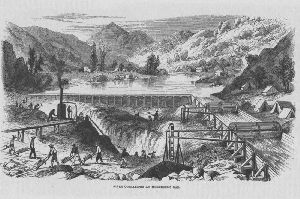
The benefit to the forty-niners was that the gold was simply "free for the taking" at first. In the goldfields, there was no private property, no licensing fees, and no taxes until a government formed.[58] The forty-niners resorted to making up their own codes and setting up their own local enforcement. The miners essentially adopted Mexican mining law existing in California.[59] For example, the rules attempted to balance the rights of early arrivers at a site with later arrivers; a "claim" could be "staked" by a prospector, but that claim was valid only as long as it was being actively worked.[60] Miners worked at a claim only long enough to determine its potential. If a claim was deemed as low-value—as most were—miners would abandon the site in search for legendary bonanza sites. In the case where a claim was abandoned or not worked upon, other miners would "claim-jump" the land. "Claim-jumping" means that a miner began work on a previously claimed site.[60] Disputes were sometimes handled personally and violently, and were sometimes addressed by groups of prospectors acting as arbitrators.[56][60] This often led to heightened ethnic tensions.
The rules of mining claims adopted by the forty-niners spread with each new mining rush throughout the western United States. The U.S. Congress finally legalized the practice in the "Chaffee laws" of 1866.[61]
Development of gold recovery techniques
Because the gold in the California gravel beds was so richly concentrated, the early forty-niners simply panned for gold in California's rivers and streams, a form of placer mining.[62] However, panning cannot be done on a large scale, and industrious miners and groups of miners graduated to placer mining "cradles" and "rockers" or "long-toms"[63] to process larger volumes of gravel.[64] In the most complex placer mining, groups of prospectors would divert the water from an entire river into a sluice alongside the river, and then dig for gold in the newly-exposed river bottom.[65] Modern estimates by the U.S. Geological Survey are that some 12 million ounces[66] (370 t) of gold were removed in the first five years of the Gold Rush (worth approximately US$7 billion at November 2006 prices).[67]
In the next stage, by 1853, hydraulic mining was used on ancient gold-bearing gravel beds that were on hillsides and bluffs in the gold fields.[68] In a modern style of hydraulic mining first developed in California, a high-pressure hose directs a powerful stream or jet of water at gold-bearing gravel beds.[69] The loosened gravel and gold would then pass over sluices, with the gold settling to the bottom where it is collected. By the mid-1880s, it is estimated that 11 million ounces (340 t) of gold (worth approximately US$6.6 billion at November 2006 prices) had been recovered via "hydraulicking."[67] This style of hydraulic mining later spread around the world.
A byproduct of this method of extraction was that large amounts of gravel and silt, in addition to heavy metals and other pollutants, went into streams and rivers.[70] Many areas still bear the scars of hydraulic mining since the resulting exposed earth and downstream gravel deposits are unable to support plant life.[71]

After the Gold Rush had concluded, gold recovery operations continued. The final stage to recover loose gold was to prospect for gold that had slowly washed down into the flat river bottoms and sandbars of California's Central Valley and other gold-bearing areas of California (such as Scott Valley in Siskiyou County). By the late 1890s, dredging technology (which was also invented in California) had become economical,[72] and it is estimated that more than 20 million ounces (620 t) were recovered by dredging (worth approximately US$12 billion at November 2006 prices).[67]
Both during the Gold Rush and in the decades that followed, gold-seekers also engaged in "hard-rock" mining, that is, extracting the gold directly from the rock that contained it (typically quartz), usually by digging and blasting to follow and remove veins of the gold-bearing quartz.[73] Once the gold-bearing rocks were brought to the surface, the rocks were crushed, and the gold was separated out (using moving water), or leached out, typically by using arsenic or mercury (another source of environmental contamination).[74] Eventually, hard-rock mining wound up being the single largest source of gold produced in the Gold Country.[67][75]
Profits
Although the conventional wisdom is that merchants made more money than miners during the Gold Rush, the reality is perhaps more complex. There were certainly merchants who profited handsomely. The wealthiest man in California during the early years of the Gold Rush was Samuel Brannan, the tireless self-promoter, shopkeeper and newspaper publisher.[76] Brannan alertly opened the first supply stores in Sacramento, Coloma, and other spots in the gold fields. Just as the Gold Rush began, he purchased all the prospecting supplies available in San Francisco and re-sold them at a substantial profit.[76] However, substantial money was made by gold-seekers as well. For example, within a few months, one small group of prospectors, working on the Feather River in 1848, retrieved a sum of gold worth more than $1.5 million by 2006 prices.[77]
On average, many early gold-seekers did perhaps make a modest profit, after all expenses were taken into account. Most, however, especially those arriving later, made little or wound up losing money.[78][79] Similarly, many unlucky merchants set up in settlements that disappeared, or were wiped out in one of the calamitous fires that swept the towns springing up.[80] Other businessmen, through good fortune and hard work, reaped great rewards in retail, shipping, entertainment, lodging,[81] or transportation.[82] Boardinghouses, food preparation, sewing, and laundry were highly profitable businesses often run by women (married, single, or widowed) who realized men would pay well for a service done by a woman. Brothels also brought in large profits, especially when combined with saloons/gaming houses.[83]
By 1855, the economic climate had changed dramatically. Gold could be retrieved profitably from the goldfields only by medium to large groups of workers, either in partnerships or as employees.[84] By the mid-1850s, it was the owners of these gold-mining companies who made the money. Also, the population and economy of California had become large and diverse enough that money could be made in a wide variety of conventional businesses.[85]
Path of the gold
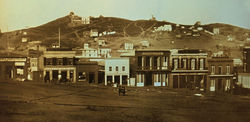
Once the gold was recovered, there were many paths the gold itself took. First, much of the gold was used locally to purchase food, supplies and lodging for the miners. It also went towards entertainment, which consisted of anything from a traveling theater to alcohol and gambling to prostitutes.These transactions often took place using the recently recovered gold, carefully weighed out.[86] These merchants and vendors, in turn, used the gold to purchase supplies from ship captains or packers bringing goods to California.[87] The gold then left California aboard ships or mules to go to the makers of the goods from around the world. A second path was the Argonauts themselves who, having personally acquired a sufficient amount, sent the gold home, or returned home taking with them their hard-earned "diggings." For example, one estimate is that some US$80 million worth of California gold was sent to France by French prospectors and merchants.[88] As the Gold Rush progressed, local banks and gold dealers issued "banknotes" or "drafts"—locally accepted paper currency—in exchange for gold,[89] and private mints created private gold coins.[90] With the building of the San Francisco Mint in 1854, gold bullion was turned into official United States gold coins for circulation.[91] The gold was also later sent by California banks to U.S. national banks in exchange for national paper currency to be used in the booming California economy.[92]
Effects
Immediate effects
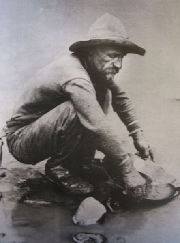
The arrival of hundreds of thousands of new people within a few years, compared to a population of some 15,000 Europeans and Californios beforehand,[93] had many dramatic effects.[94]
First, the human and environmental costs of the Gold Rush were substantial. Native Americans became the victims of disease, starvation and genocidal attacks;[95] the Native American population, estimated at 150,000 in 1845, was less than 30,000 by 1870.[96] It is estimated that some 4,500 Native Americans suffered violent deaths between 1849 and 1870.[97] Explicitly racist attacks and laws sought to drive out Chinese and Latin American immigrants.[98] The toll on the American immigrants could be severe as well: one in twelve forty-niners perished, as the death and crime rates during the Gold Rush were extraordinarily high, and the resulting vigilantism also took its toll.[99] In addition, the environment suffered as gravel, silt and toxic chemicals from prospecting operations killed fish and destroyed habitats.[70][71]
However, the Gold Rush propelled California from a sleepy, little-known backwater to a center of the global imagination and the destination of hundreds of thousands of people. The new immigrants often showed remarkable inventiveness and civic-mindedness. For example, in the midst of the Gold Rush, towns and cities were chartered, a state constitutional convention was convened, a state constitution written, elections held, and representatives sent to Washington, D.C. to negotiate the admission of California as a state.[100] Large-scale agriculture (California's second "Gold Rush"[101]) began during this time.[102] Roads, schools, churches,[103] and civic organizations quickly came into existence.[100] The vast majority of the immigrants were Americans. Pressure grew for better communications and political connections to the rest of the United States, leading to statehood for California on September 9, 1850, in the Compromise of 1850 as the 31st state of the United States.
Between 1847 and 1870, the population of San Francisco increased from 500 to 150,000.[104] The Gold Rush wealth and population increase led to significantly improved transportation between California and the East Coast. The Panama Railway, spanning the Isthmus of Panama, was finished in 1855.[105] Steamships, including those owned by the Pacific Mail Steamship Company, began regular service from San Francisco to Panama, where passengers, goods and mail would take the train across the Isthmus and board steamships headed to the East Coast. One ill-fated journey, that of the S.S. Central America,[106] ended in disaster as the ship sank in a hurricane off the coast of the Carolinas in 1857, with an estimated three tons of California gold aboard.[107][108]
Within a few years after the end of the Gold Rush, in 1863, the groundbreaking ceremony for the western leg of the First Transcontinental Railroad was held in Sacramento. The line's completion, some six years later, financed in part with Gold Rush money,[109] united California with the central and eastern United States. Travel that had taken weeks or even months could now be accomplished in days.[110]
The Gold Rush stimulated economies around the world as well. Farmers in Chile, Australia, and Hawaii found a huge new market for their food; British manufactured goods were in high demand; clothing and even pre-fabricated houses arrived from China.[111] The return of large amounts of California gold to pay for these goods raised prices and stimulated investment and the creation of jobs around the world.[112] Australian prospector, Edward Hargraves, noting similarities between the geography of California and his home, returned to Australia to discover gold and spark the Australian gold rushes.[113]
Long-term effects
California's name became indelibly connected with the Gold Rush, and as a result, was connected with what became known as the "California Dream." California was perceived as a place of new beginnings, where great wealth could reward hard work and good luck. Historian H. W. Brands noted that in the years after the Gold Rush, the California Dream spread to the rest of the United States and became part of the new "American Dream."
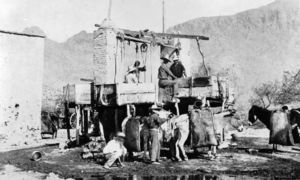
| " | "The old American Dream . . . was the dream of the Puritans, of Benjamin Franklin's Poor Richard . . . of men and women content to accumulate their modest fortunes a little at a time, year by year by year. The new dream was the dream of instant wealth, won in a twinkling by audacity and good luck. [This] golden dream . . . became a prominent part of the American psyche only after [Sutter's Mill]."[114] | " |
Generations of immigrants have been attracted by the California Dream. California farmers,[115] oil drillers,[116] movie makers,[117] airplane builders,[118] and "dot-com" entrepreneurs[119] have each had their boom times in the decades after the Gold Rush.
Included among the modern legacies of the California Gold Rush are the California state motto, "Eureka" ("I have found it"), Gold Rush images on the California State Seal,[120] and the state nickname, "The Golden State," as well as place names, such as Placer County, Rough and Ready, Placerville (formerly named "Dry Diggings" and then "Hangtown" during rush time), Whiskeytown, Drytown, Angels Camp, Happy Camp, and Sawyer's Bar. The San Francisco 49ers National Football League team, and the similarly named athletic teams of California State University, Long Beach, are named for the prospectors of the California Gold Rush. The literary history of the Gold Rush is reflected in the works of Mark Twain (The Celebrated Jumping Frog of Calaveras County), Bret Harte (A Millionaire of Rough-and-Ready), Joaquin Miller (Life Amongst the Modocs[28]), and many others.
Today, aptly-named State Route 49 travels through the Sierra Nevada foothills, connecting many Gold Rush-era towns such as Placerville, Auburn, Grass Valley, Nevada City, Coloma, Jackson, and Sonora.[121] This state highway also passes very near Columbia State Historic Park, a protected area encompassing the historic business district of the town of Columbia; the park has preserved many Gold Rush-era buildings, which are presently occupied by tourist-oriented businesses.
Geology

Scientists believe that global forces operating over hundreds of millions of years resulted in the large concentration of gold in California. Only gold that is concentrated can be economically recovered. Some 400 million years ago, California lay at the bottom of a large sea; underwater volcanoes deposited lava and minerals (including gold) onto the sea floor. Beginning about 200 million years ago, tectonic pressure forced the sea floor beneath the American continental mass.[122] As it sank, or subducted, below today's California, the sea floor melted into very large molten masses (magma). This hot magma forced its way upward under what is now California, cooling as it rose,[123] and as it solidified, veins of gold formed within fields of quartz.[123][124] These minerals and rocks came to the surface of the Sierra Nevada,[125] and eroded. The exposed gold was carried downstream by water and gathered in quiet gravel beds along the sides of old rivers and streams.[126] The forty-niners first focused their efforts on these deposits of gold, which had been gathered in the gravel beds by hundreds of millions of years of geologic action.[127][128]
See also
- List of people associated with the California Gold Rush
- Virginia gold mining (beginning 1804)
- Georgia Gold Rush (beginning 1829)
- Australian gold rushes (1850s)
- Ballarat (Australia) Gold Rush (1851)
- Fraser Canyon Gold Rush (late 1850s)
- Pike's Peak Gold Rush (1858–1860)
- Central Otago Gold Rush (1860s)
- Holcomb Valley gold rush (1860s)
- Witwatersrand Gold Rush (1880s)
- Klondike Gold Rush (1890s)
- History of the west coast of North America
- History of California to 1899
This article is copied from an article on Wikipedia® - the free encyclopedia created and edited by online user community. The text was not checked or edited by anyone on our staff. Although the vast majority of the Wikipedia® encyclopedia articles provide accurate and timely information please do not assume the accuracy of any particular article. This article is distributed under the terms of GNU Free Documentation License.
Thanks to Encyclopedia The Free Dictionary / Farlex, Inc.
http://encyclopedia.thefreedictionary.com/p/California%20Gold%20Rush
| Amazon Magazine Subscriptions | Amazon Books | Amazon Kindle Store |
| Amazon Everyday Low Prices, Sales, Deals, Bargains, Discounts, Best-Sellers, Gifts, Household Consumer Products | ||


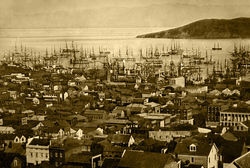

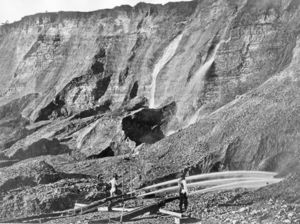
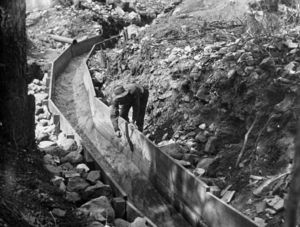

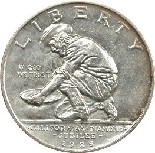
No comments:
Post a Comment